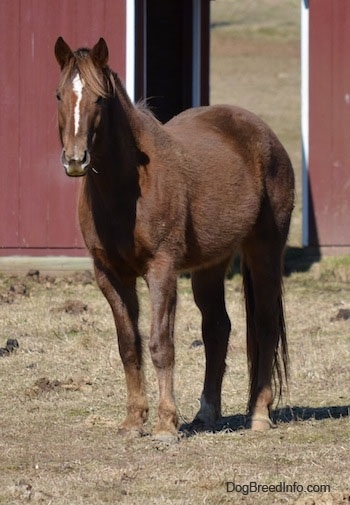
Scooter the Appendix horse (Thoroughbred / Quarter horse cross) at 10 years old
A large-hoofed, warm-blooded mammal (Equus caballus).
Owning a horse is a very rewarding experience, but it is not for everyone. Be sure to thoroughly research before taking on the responsibility of owning a horse. If you want to learn to ride it is a good idea to take horseback riding lessons. If you enjoy it you may want to consider leasing a horse. There are many barns which will board your horse for you and allow you to come and ride anytime. Some of them will do the majority of the work involved in owning a horse, however this can get pricey. Know the horse you are riding. Horses spook very easily. Simple things like sticks and forest animals commonly spook horses. When riding a horse a helmet should be worn at all times.
There are two different types of riding, Western and English. Western generally consists of barrel racing, keyhole and pole racing among other events, whereas English generally consists of dressage, jumping, polo, Lacrosse and more. When dressage is performed it looks like the horse is dancing. The rider is guiding the horse through a series of complex maneuvers by slight movements of the rider's hands, legs and weight. The saddle a Western rider uses is different than the saddle an English rider would use. One key difference is the Western saddle consists of a horn, while the English saddle does not.
Un-neutered male horses tend to fight with other horses. If you plan on keeping a male horse with a herd of other horses it is a good idea to get it fixed.
An average sized horse is between 14 and 15 hands high (a hand = 4 inches). Horses range from about 1000 lbs. to 3500 lbs.
For every horse you need to have at least three acres and an additional acre for every additional horse. The area must be fenced in. Some use barbed wire or electric fences to secure their horses. Barbed wire is one of the most dangerous fences to use around horses. Most horses wouldn't see the wire because it is too thin for them to see. They can get cut and even caught in it. They need some kind of shelter, at the very least a lean-to to shield them from the wind and rain. Some horses are hardier and can get away with a lean-to, but some horses are on schedules and need to be put in a stall for a period of time during the day or night.
About every two days, you might need to muck (clean) your horse's stall or lean-to.
Horses need daily grooming. This includes: picking their hooves, combing their mane, brushing with a curry comb (hard brush) then a soft brush after to get the loose dirt off, bathing after workouts, and using fly spray. About every three months, some horses should seen by a farrier to determine if their hooves need to shaped. Daily grooming will reduce stress, keep your horse comfortable, healthy and looking great!
Horses need hay daily or a field with plenty of grass to graze on. Some horses require grain, oats, bran, sweet feed and hay pellets. Horses can eat all the hay they like, however too much grain can harm them. Grain has to be carefully monitored. Horses drink water and should have it provided at all times when out grazing or when in a stall. Be sure to keep the water clean. When a horse drinks it often back washes back into the supply. Their water needs to be changed and refilled often.
Horses require daily exercise. They need to have enough land to exercise themselves and most enjoy having a person to ride them. Horses need companionship, either another horse(s), or some other farm animal. Some owners have been known to use animals such as goats, cows and sheep to keep them company. In general, horses will not be happy living alone.
A healthy horse will live to about 45 years old.
Some health problems include: colic (a common killer of horses, a bad stomach ache), worms, lameness, tying-up, hoof cracks, dental problems and hoof wall loss.
--
The first breed of horses was called the Eohippus. It lived 5,000 or 6,000 years ago. It had toes unlike domestic horses today that have hooves. It was as big as a border collie and according to research, it had spots on its back.
Saddle - A leather seat for a horse rider, secured on an animal's back by a girth.
Bridle - A harness, consisting of a headstall, bit, and reins, which fits on a horse's head and used to restrain or guide the animal.
Crop - A short whip used in horseback riding, with a loop at the end.
Halter - A device that fits around the head or neck of an animal and is used to lead or secure the animal.
Hackamore - A bitless bridle, sometimes used to break a horse into a bridle.
Reins - A long narrow leather strap attached to each end of the bit of a bridle and used by a rider or driver to control a horse or other animal.
Saddle Pad - A padded blanket that goes between the horse's back and the saddle to prevent irritation.
Bit -The metal mouthpiece of a bridle, serving to control and direct an animal.
Stirrups - A device where the rider puts their foot hung from either side of a horse's saddle to support the rider's foot in mounting and riding.
Gelding - A neutered male horse.
Stallion - An intact (un-neutered) male horse.
Mare - A female horse.
Foal - A baby horse.
Filly - A female baby horse.
Colt - A male baby horse.
A herd of horses and ponies
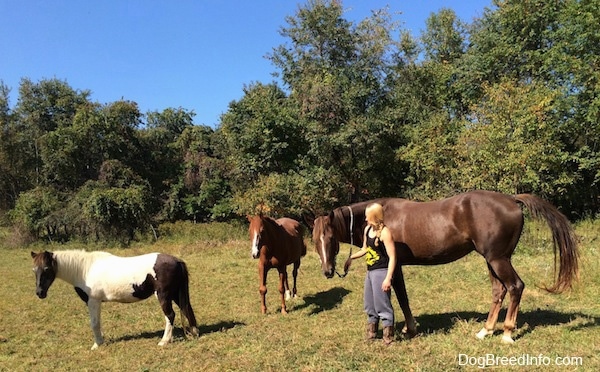
Amie with her horses Jazzmine the paint pony, Jack the Mexican quarter horse and Scooter the Appendix horse.
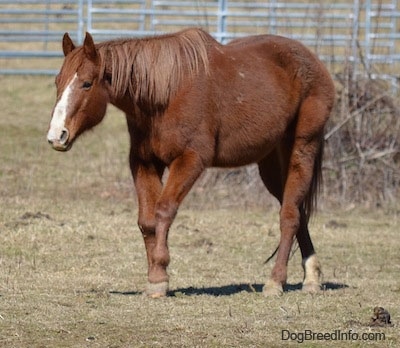
Jack the Mexican Quarter horse at 26 years old
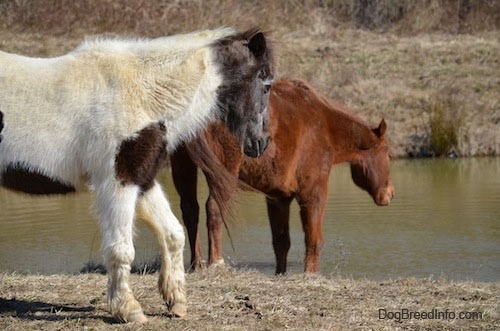
Jack the Mexican Quarter horse at 26 years old with Jazzmine the paint pony at 30 years old drinking from the pond
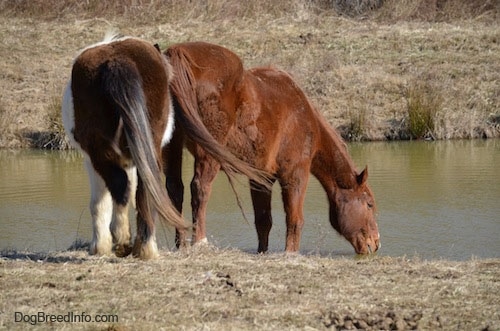
Jack the Mexican Quarter horse at 26 years old with Jazzmine the paint pony at 30 years old drinking from the pond
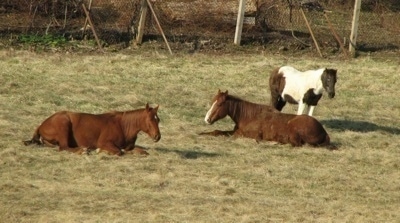
"Zoey, Jack and Jazzmine; Zoey and Jack (lying down) are Quarter Horses and Jazzmine is a paint pony. Zoey was a new horse and had just met Jack and Jazzmine the day before. The first day was rough as Jazz the pony wanted nothing to do with Zoey. Jazz was chasing her, kicking at her, snorting warnings and trying to keep her away from Jack. But we knew that would happen because ponies are like that and females are even worse. Jack was running between the two mares, stopping Jazz from hurting Zoey, over and over. What a sight that was. Poor Jack's got to live with two girls! It'll take time for Jazz to like her. A few hours before this picture was taken I was outside and herd Jazz the paint pony snort a warning as she was about to kick at Zoey. I yelled up to her that she was a bad girl and she stopped. A few seconds later Jazz geared up for another kick and I yelled again. This time all three horses stood there looking at me. Jazz walked away from Zoey. Jazz is establishing herself as the leader with the new horse. It looks like they are going to all be friends eventually."Photo courtesy of Horses with Amie
Jack the Mexican Quarter Horse, imported to the USA
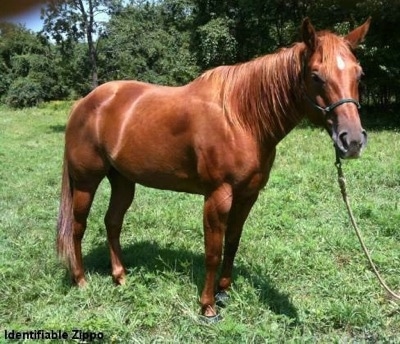
Zoey is a 1999 sorrel mare AQHA Quarter Horse.
Spike the Bulldog saying hello to the horses
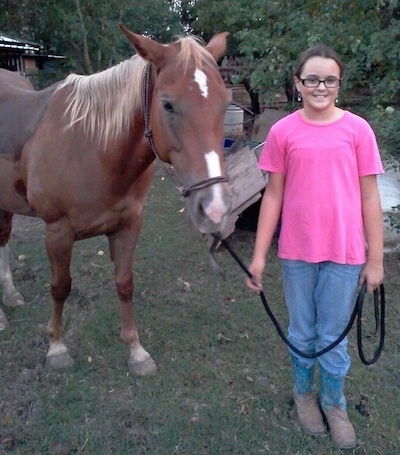
Faith the Quarter horse at 8 years old—"Faith is an all American Quarter horse. She loves doing barrels and poles."
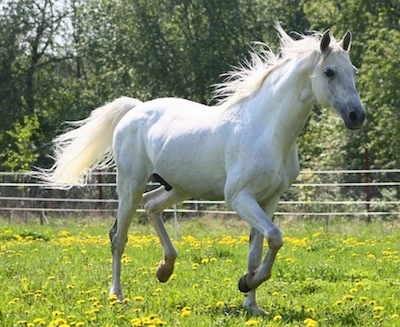
"This is my five-year-old Andalusian horse named Chase. We call him Chase because he likes to jump and run around a lot as seen in this picture."
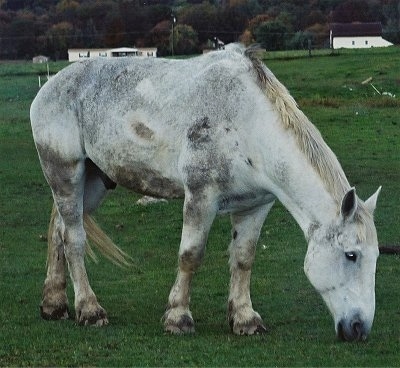
Amish working horse, dapple gray Percheron draft horse
Filly the Quarter Horse colt at 2 weeks old
Filly the Quarter Horse colt at 2 weeks old checking out the barn cat
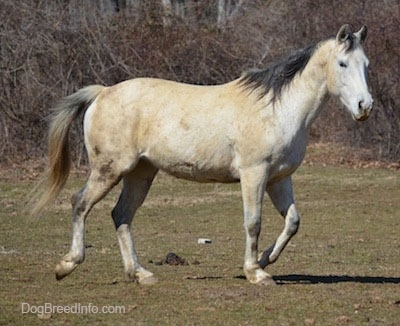
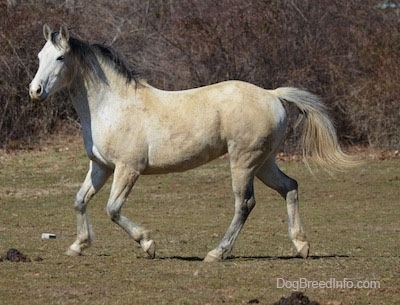
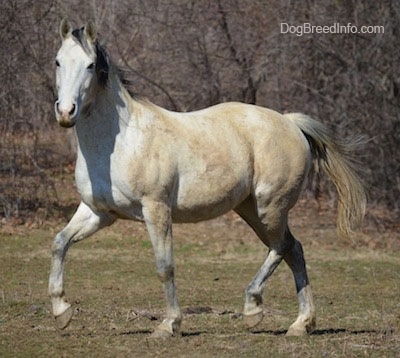
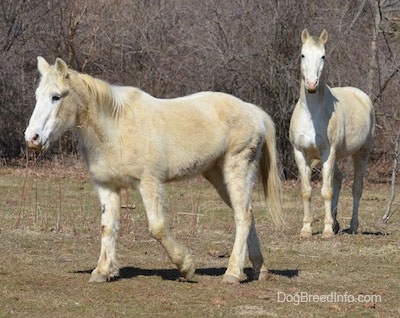
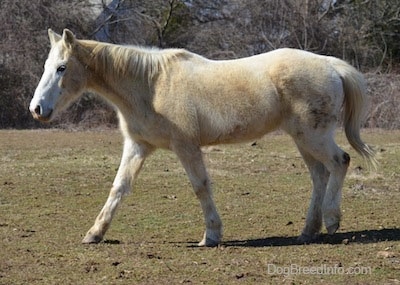
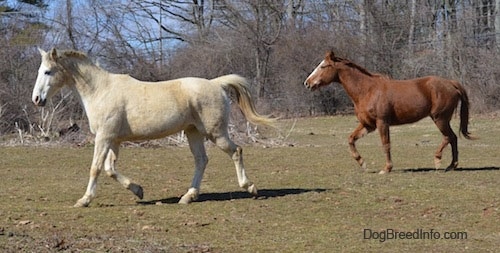
Information written by Amie and Jessica, edited by Dog Breed Info Center®